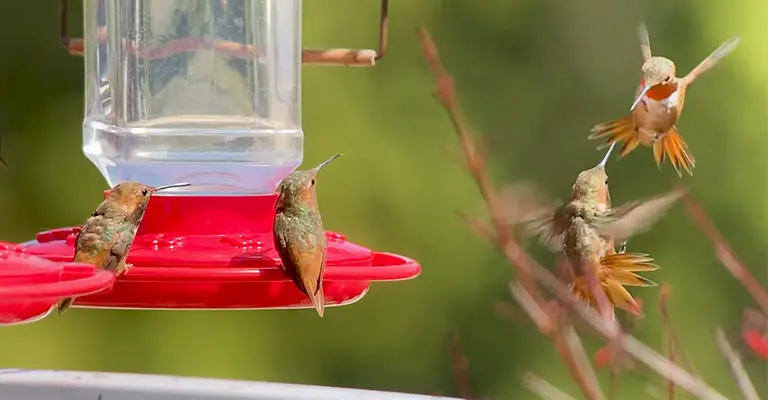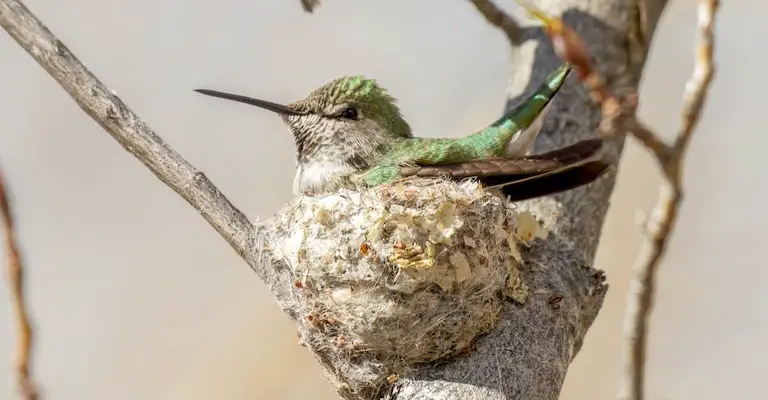Hummingbirds, with their dazzling colours and remarkable aerial abilities, captivate our attention. However, their charming facade often conceals a fiercely territorial nature.
Understanding why hummingbirds are so territorial unveils the motivations behind their behaviour and sheds light on the intricate dynamics of their survival strategies.
In this guide, we will delve into why are hummingbirds so territorial, exploring the factors that drive their territorial behaviour and the benefits it offers in their quest for resources and reproductive success.

Why Are Hummingbirds So Territorial?
Hummingbirds are known for their territorial behaviour, and there are several reasons why they exhibit such territorial tendencies. Here are some key points to consider regarding why hummingbirds are territorial:
Resource Competition
One primary reason for hummingbird territoriality is resource competition. Hummingbirds rely on floral nectar as their primary food source, and they vigorously defend territories with abundant nectar-producing flowers.
By establishing and defending territories, hummingbirds can ensure a sufficient and exclusive food supply, reducing competition for limited resources.
Energy Conservation

Hummingbirds have extremely high metabolic rates and require a substantial amount of energy to sustain their rapid wingbeats.
Defending a territory with ample food sources allows hummingbirds to conserve energy by minimizing the distance they need to travel for nectar. It ensures a consistent food supply in a concentrated area, saving valuable energy reserves.
Mating Opportunities
Territorial behaviour in hummingbirds is also related to reproductive success. Males often establish territories that encompass prime foraging areas and attractive perches to attract potential mates.
By defending these territories, males can maximize their chances of attracting and courting females, increasing their reproductive success.
Nesting Site Protection

Hummingbirds fiercely defend their chosen nesting sites. Female hummingbirds select secure and well-hidden locations for their nests, often in trees or shrubs.
By being territorial, they discourage potential intruders and predators, ensuring the safety and survival of their offspring.
Defence against Intruders
Hummingbirds are known to aggressively ward off other hummingbirds and even larger birds that encroach upon their territories. By displaying aerial acrobatics, vocalizing, and engaging in aggressive displays like dive-bombing, they deter potential rivals or predators.
This territorial defence helps maintain their exclusive access to resources and protects their overall well-being.
It’s important to note that not all hummingbird species exhibit the same level of territoriality, and the extent of territorial behaviour can vary among individuals.
Additionally, factors like habitat availability and population density can influence the intensity of territorial behaviour in hummingbirds.
How Do Hummingbirds Protect Themselves?

Hummingbirds have evolved several mechanisms to protect themselves and ensure their safety in their natural environments. Here are some key ways in which hummingbirds protect themselves:
Agility and Flight Skills
Hummingbirds are incredibly agile flyers, capable of rapid acceleration, precise manoeuvring, and even flying backwards. Their agility enables them to swiftly navigate through their surroundings, making it challenging for predators to catch them.
They can quickly change direction or hover in mid-air, evading potential threats.
Speed and Evasive Maneuvers
Hummingbirds are known for their remarkable speed, with some species capable of reaching up to 60 miles per hour in flight.
When faced with a predator or perceived threat, hummingbirds employ evasive manoeuvres, including sudden bursts of speed, erratic flight patterns, or dive-bombing, to confuse and elude their pursuers.
Camouflage and Cryptic Coloration
Many hummingbird species have evolved plumage that provides effective camouflage in their natural habitats.
Their colours blend with the surrounding foliage, making them difficult to spot by both predators and prey. Additionally, some species have iridescent feathers that can change colour depending on the angle of light, further aiding in camouflage.
Aggressive Displays

Hummingbirds are not afraid to defend themselves aggressively. When faced with a threat, they may engage in aggressive displays, such as dive-bombing, vocalizing, or flashing their brightly coloured feathers.
These displays not only intimidate predators but also communicate a clear message of territorial defence, warning other birds to stay away.
Stealth and Alertness
Hummingbirds possess sharp senses and a keen awareness of their surroundings. They are constantly vigilant and alert to potential dangers, including predators or other territorial hummingbirds.
Their acute vision and hearing help them detect approaching threats, allowing them to take evasive action or seek cover before an attack occurs.
Nesting Site Selection
Hummingbirds select nesting sites that offer concealment and protection. They often choose locations that are well-hidden, such as dense vegetation, trees, or shrubs, to build their nests.
These strategic choices provide natural camouflage and make it harder for predators to locate and access their vulnerable nests.
Through a combination of their agility, flight skills, evasive manoeuvres, camouflage, aggressive displays, alertness, and strategic nesting site selection, hummingbirds have adapted a range of effective defences to protect themselves from predators and ensure their survival in their unique habitats.
FAQ
Hummingbirds are territorial primarily to secure exclusive access to vital resources, such as nectar-producing flowers or feeders. By defending territories, they ensure a reliable food supply, reducing competition and increasing their chances of survival.
Not all hummingbird species exhibit the same level of territorial behaviour. Some species are more territorial than others, depending on factors like habitat, resource availability, and breeding strategies.
However, territorial behaviour is common among many hummingbird species.
Hummingbirds benefit from being territorial in various ways. They can access abundant food sources without competition, establish breeding territories to attract potential mates, protect their nests and offspring, and assert dominance over rivals to enhance their reproductive success.
Hummingbirds may defend territories year-round in regions with consistent food sources. However, in areas with seasonal fluctuations, they are more likely to exhibit territorial behaviour during the breeding season or when food resources are limited.
Yes, territorial behaviour can be observed in urban or backyard settings, especially if there are nectar-rich flowers or feeders that attract hummingbirds. They will defend these feeding territories against intruding hummingbirds, displaying aggressive behaviours to maintain exclusive access to the food resource.
Conclusion
The territorial nature of hummingbirds is rooted in their pursuit of resources and reproductive success. The drive to secure exclusive access to food sources, establish breeding territories, protect nesting sites, and assert dominance over rivals fuels their territorial behaviour.
By fiercely defending their territories, hummingbirds ensure a consistent food supply, attract potential mates, safeguard their vulnerable nests, and enhance their chances of successful reproduction.
The territoriality of hummingbirds unveils the intricate strategies they have developed to survive and thrive in their habitats.
As we admire their vibrant beauty and observe their territorial displays, let us appreciate the remarkable adaptations that enable hummingbirds to navigate their competitive and challenging environments with such tenacity and determination.